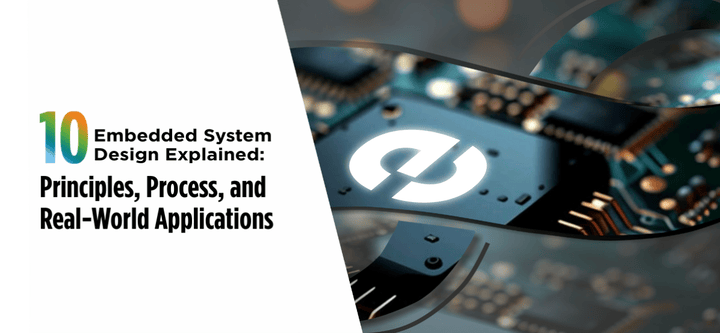In an age where IoT devices are embedded into nearly every aspect of life — from smart homes to fintech terminals — embedded systems form the invisible backbone of innovation. Compact, efficient and mission-specific, these systems drive intelligence and autonomy across industries.
According to the 2025 Embedded Systems Market Trends Report by MarketsandMarkets (January 2025), the global embedded systems market is expected to reach USD 139.8 billion by the end of 2025, growing at a CAGR of 6.7%. This explosion is driven largely by the rapid adoption of IoT devices, autonomous vehicles and smart infrastructure across the globe.
But what exactly goes into designing an embedded system? What makes it tick — and more importantly, what makes it reliable, secure and scalable?
Let’s break it down in 10 essential parts, with real-world insights and examples from industry leaders like Evolute Group, which designs advanced embedded IoT-enabled fintech and energy solutions for India’s digital future.
1. System Scope and Mission Code
Before soldering a single chip, engineers must define the functional requirements — what the system is meant to do. Whether it’s powering a biometric device or monitoring solar input, scope clarity is critical.
In January 2025, STMicroelectronics released a white paper noting that 78% of embedded system design failures are due to undefined or evolving functional requirements. The golden rule? Design with the end in mind.
2. Microcontrollers: The Compact Commanders
At the heart of most embedded systems lies the microcontroller (MCU) — a small computer on a single integrated circuit. It includes a processor, memory and I/O interfaces, all optimized for specific tasks.
The 2025 release of ARM Cortex-M55, now widely adopted in IoT devices and wearables, offers neural processing capabilities and enhanced power efficiency — a big win for battery-based embedded devices.
Evolute’s micro-ATMs and payment terminals, for instance, run on ARM-based architecture, enabling secure and fast offline transactions in rural zones.
3. Firmware Flow — The Invisible Brain
Firmware is the low-level software programmed into the ROM of an embedded system. It controls device behavior at the most fundamental level.
According to the IEEE Embedded Systems 2025 Journal, more than 90% of IoT devices rely heavily on firmware efficiency to ensure real-time processing and low-latency execution. Poor firmware design leads to overconsumption of memory and frequent system crashes.
Modern embedded solutions, including Evolute’s solar charge controllers, now support OTA firmware updates, ensuring longevity and adaptability.
4. Sensor Integration — Machines with a Sense
Whether it’s a temperature sensor in a cold chain tracker or a biometric reader in a fintech kiosk, sensor integration is key. Sensors collect the real-world data that embedded systems act upon, enabling automated responses and intelligent decision-making.
In March 2025, Statista reported that the sensor market tied to embedded IoT grew by 19.4% YoY, driven by demand from smart wearables, agricultural automation and embedded medical devices.
More advanced embedded systems now feature multi-sensor fusion, where inputs from various types of sensors are combined to enhance accuracy and reliability. This is particularly vital in biometric authentication and environmental monitoring applications.
5. Power Management — Efficiency is King
In embedded systems, power isn’t just about performance — it’s survival. Especially in remote IoT devices, such as Evolute’s field-deployed micro-ATMs and smart meters, power optimization is crucial.
Low-power modes, energy harvesting (solar, vibration) and advanced battery management systems (BMS) are now embedded into design strategies. Texas Instruments (April 2025) reports that embedded systems using dynamic power scaling can improve efficiency by up to 40%.
6. Connectivity: Wired, Wireless and Beyond
Modern embedded systems don’t function in silos. They must communicate via Bluetooth, Wi-Fi, Zigbee, NB-IoT, or 5G.
The IoT Connectivity Survey by GSMA (Feb 2025) showed that 61% of embedded system designers now prefer LPWAN technologies like NB-IoT and LoRa for long-range, low-power applications.
Evolute integrates NB-IoT modules into its energy meters to ensure reliable telemetry in power-scarce regions.
7. Real-Time Operating Systems (RTOS): The Task Juggler
When multiple processes need to run simultaneously — like reading a sensor, displaying info and responding to user input — a real-time operating system (RTOS) ensures efficient multitasking.
The newly launched FreeRTOS 2025, with enhanced kernel scalability and support for AI acceleration, is being integrated into mission-critical IoT devices across the globe.
RTOS is pivotal in Evolute’s devices where millisecond-level responsiveness can make or break transaction integrity.
8. Security by Design — Not as an Afterthought
With the rise in IoT-related cyberattacks (Kaspersky March 2025 notes a 21% spike YoY), embedding security protocols at the hardware level is non-negotiable.
Techniques such as Secure Boot, hardware-based encryption modules and TPM chips are standard in Evolute’s payment and identity devices.
This embedded security ensures that IoT devices can resist sophisticated attacks, safeguarding sensitive data and maintaining system integrity even in the most hostile environments.
“Security should not be an accessory — it must be embedded from byte one.” – Jensen Huang, CEO, NVIDIA
9. Testing the Tiniest Bugs
Rigorous testing — both automated and manual — is essential. Every system is subjected to unit testing, integration testing and HIL (Hardware-in-the-Loop) simulation before mass deployment.
The 2025 Embedded Benchmark Consortium Report found that companies that test at every stage of the development cycle reduce post-deployment bugs by 57%.
Testing is an ongoing process, ensuring that embedded systems not only function optimally but are also resilient to unexpected failures or edge cases, which is crucial for mission-critical applications in fields like healthcare, transportation and financial services.
10. Real-World Deployment and Maintenance
Finally, embedded systems don’t end at deployment. Remote diagnostics, updates and telemetry are vital for long-term performance.
Evolute’s cloud-connected fintech terminals receive firmware patches over 4G networks, ensuring compliance with RBI mandates and security standards without field recalls.
In addition, over-the-air (OTA) updates allow for continuous improvements and bug fixes, ensuring that devices remain up-to-date with the latest security protocols and performance enhancements.
Evolute Group – Engineering Embedded Intelligence
As a pioneer in embedded solutions for the fintech, energy and industrial sectors, Evolute Group combines cutting-edge microelectronics, secure firmware and real-time data systems to empower India’s digital growth. From IoT-enabled biometric devices to smart micro-ATMs and contactless payment terminals, Evolute’s embedded systems are robust, scalable and tailored for mission-critical deployments — especially in underserved rural and semi-urban landscapes. The company’s commitment to indigenous design, modularity and long-life product support positions it as a trusted partner in India’s embedded future.
In Summary – The Embedded Design Mantra
Designing embedded systems is a meticulous blend of hardware excellence, firmware precision and foresight-driven architecture. In 2025 and beyond, as IoT devices continue to redefine business operations and consumer lifestyles, embedded systems will only grow more intelligent and indispensable.
Key Takeaways:
- Embedded systems are the core of IoT device intelligence, driving automation and real-time control.
- The 2025 embedded systems market is expected to reach USD 139.8 billion.
- Evolute Group is at the forefront of India’s embedded innovation across fintech and energy tech.
- Key design aspects include firmware, microcontrollers, RTOS, power optimization and hardware security.
- Real-world use cases: FinTech terminals, smart meters, biometric devices and energy management tools.
- Future trends: AI-enabled firmware, remote diagnostics, OTA updates and low-power long-range connectivity.
Looking to build next-gen embedded IoT solutions for rural reach or industrial intelligence? Evolute Group offers the tools, teams and technology to make it real.





